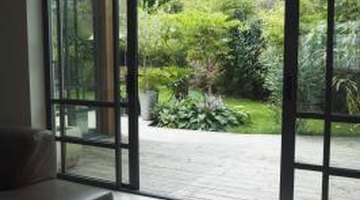Water Leaks Above the Eaves & Soffits of Sliding Glass Doors
Leaking sliding glass doors present a problem for homeowners because it indicates a broken or damaged seal. The manufacturer adds a seal to the top and side of each door, which keeps water from seeping inside. When you notice the problem, it also might mean that cold air or warm air can also find a way into your home. The leaks often present around the eaves and soffits.
Potential Causes

According to Sheetal Werneke of The Money Pit, leaking above the glass door is likely a sign of damaged flashing. Flashing is the seal placed around the glass that keeps the door from rubbing against the surrounding wall. Any time a wall has an opening, that opening becomes a vulnerable spot. The opening weakens the wall, letting in cold air, hot air and water from snow or rain. In some cases, the damage occurs as the result of weakened wood above the doors. The wood breaks down and absorbs moisture, which slowly drips through the top of the doors.
Do-It-Yourself Solutions
A simple method of solving the solution is with a product that works like flashing. Clear silicone caulk works like a sealant and stops water from leaking inside the doors. The caulk creates a protective barrier around the eaves and soffits. Hardware stores and home improvement stores sell do-it-yourself flashing kits that include everything you need for installing new flashing around doors. The kits work with a variety of wall surfaces, including brick, concrete and wood.
Warning
The longer you leave the leak untreated, the worse the problem becomes. As the water pools around the doors, it causes damage to the wall surrounding the door. On the outside of the home, the water can seep under your siding, leading to mold, mildew and rotting on the wood. You might also notice rotting and moisture damage inside your home, especially around the doors. Moisture damage affects plaster and drywall, causing peeling of paint or wallpaper.
Considerations
Depending on the installation of your sliding glass doors, the surface might feature existing caulk. Any damage to the caulk, including cracks or chips can lead to leaks. Examine the door carefully, looking at the caulk. A putty knife scraped along the door frame should have enough pressure to loosen the existing caulk and leave behind a smooth surface. Applying new caulk to old caulk is risky because as the material expands, it might block the door from opening properly.
References
Writer Bio
Jennifer Eblin has been a full-time freelance writer since 2006. Her work has appeared on several websites, including Tool Box Tales and Zonder. Eblin received a master's degree in historic preservation from the Savannah College of Art and Design.
Photo Credits
- Jupiterimages/Comstock/Getty Images
More Articles



